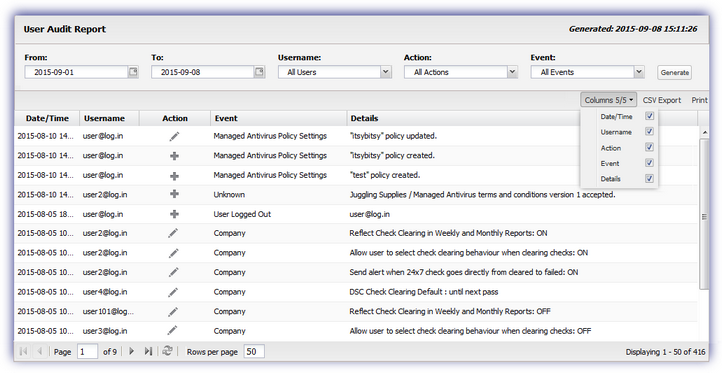User Audit Report

The User Audit Report records All Devices view actions and events including:
- Agent installation and removal
- Check additions and deletions
- Policy changes
- User log ins
- User actions on the All Devices view
You can use filters in the report to limit the returned information, and combine filters to provide more targeted results. For example, select the Event type as Device and Action as Delete to display removed devices.
Generate a User Audit Report:
- On the All Devices view, go to Reports > User Audit Report.
- Choose a date range for the report.

- Filter by Username, Action and Event (optional) .
- Select Generate to open the report in your browser, or select CSV Export to download the full report to your computer as a file including all columns.
In your browser, you can choose the report’s Columns from the dropdown menu and click the column headings to re-order the data. To export the Report including the current column view, use the CSV Export or Print button.
Report filters
- From: Select the report start date from the calendar picker (D/M/Y)
- To: Select the report end date from the calendar picker (D/M/Y)
- Username: Filter by all users or a specific user
- Action: Include all actions or a specific action type
- Event: Include all events or a specific event type
Icons
-
 Add or user logged in or out
Add or user logged in or out -
 Edit
Edit -
 Delete
Delete
Pagination
Even when filtered, the User Audit Report may return a large amount of data. To limit the number of rows displayed per page, enter the desired number in Rows per page, then use the arrows to move between pages. Select ![]() refresh to reload the report.
refresh to reload the report.
Pagination settings do not apply to the CSV Export of the User Audit Report.
Report export options
After you generate a User Audit Report, two export options appear above the North-pane:
- CSV Export: Saves all filtered data (including hidden columns) as a CSV file. The file is named using the format DATE_FROM-UserAuditReport.csv (for example, 2025-08-01-UserAuditReport.csv).
- Print: Prints the current report view as displayed. Hidden columns are excluded. Available print options depend on the configuration of the device used to view the report.
